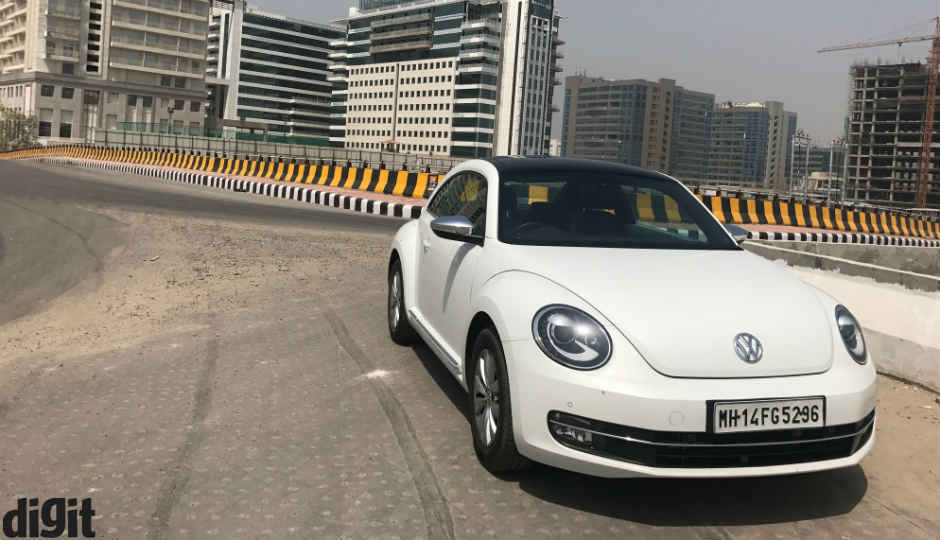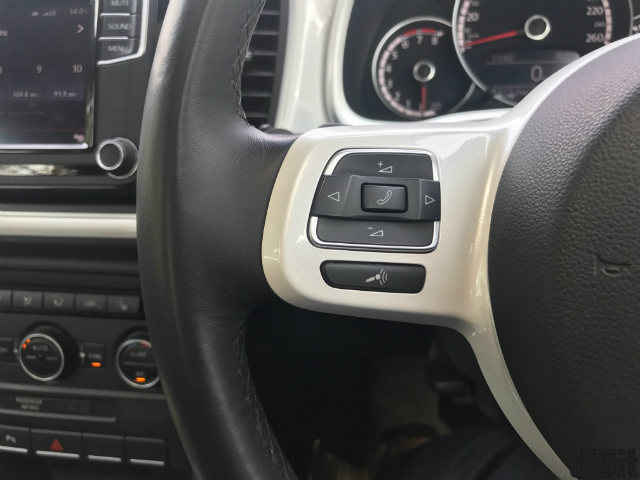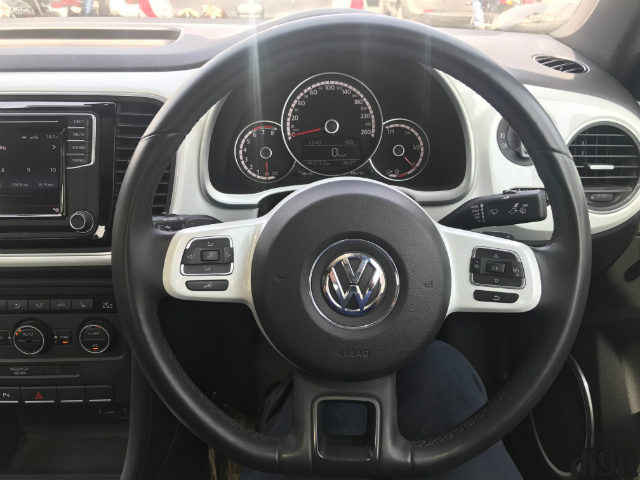Volkswagen Beetle review: The iconic design gets young upgrades

The iconic Volkswagen Beetle turns heads wherever it goes, and even includes ample technology inside to suit the car's young demeanours.
Cars are a lot about technological advancements and mechanical precision. Some cars, meanwhile, are more about the emotions that surround it. Still, some encapsulate much more than technology, engineering and emotions, which include a rich history that elevates them to iconic status. Enter, the Volkswagen Beetle.
The Beetle that is being sold in India is not a new car, and has been around for quite some time now. It is also not a car that is loaded with futuristic technology, which makes it a very pleasant diversion from cars that tend to include more settings and options than you would ever usually access. The Volkswagen Beetle is all about its iconic status, and the immediately recognisable design that makes head turn wherever you go.
The ‘Beetle’ design dates back to the years of the Second World War, with Ferdinand Porsche usually being credited with the car’s design. This was strikingly similar to the May Bug, made by Jewish engineer Josef Ganz, and another family car made by Tatra, now hailed as the second oldest car company in the world right now after Peugeot. It is this that spurned on the history of ‘Volkswagen’, the people’s car, and the Beetle had an irrefutable role to play in it.
Design
Moving on to 2017, and the Beetle has been through numerous design changes to now look more modern. The new Beetle is more contemporary, with smooth, proportional bulges that attempt to keep the spirit alive for one of the longest production vehicles in the entire history of automobiles. The front and rear bumpers fuse seamlessly with the main body, and there is neat synchronisation of the way the bonnet sits on top of the rounded front wheel arches.
It is the front facade of the VW Beetle that sets the tone for the rest of the car’s design, and it follows suit with the theme for the entire vehicle. The rounded milestone rear lamps look a bit simplistic, but fits the contemporary design statement fairly well. The contrasting spoiler adds more persona to the smoothly inclined rear of the car, and so does the contrast-coloured roof with an integrated sunroof. These, though, are part of the optional package, which you may opt for at additional expense.
The cabin looks nicely proportionate from the outside, and the overall design means you only get two doors. You should technically need only two here, as the rear seats are not where the essence of the Volkswagen Beetle lies. The bleeding edge doors without a window frame add to the overall jazz, although the overall interiors are not really striking. The design statement continues with the smooth flow, and the addition of body-coloured dash strip and steering wheel inserts on two spokes look quite pleasant.
The design is not overwhelming, but it is not meant to be so. The Volkswagen Beetle associates itself with subtle emotions, one that will be appreciated by everyone. It is this that the Beetle achieves with effortless grace, and negates the fact that there are better, sharper designs around. We still love the Volkswagen Beetle for its easing grace and the immediately recognisable design, and it is this car that makes every head turn wherever you go.
Technology inside
Volkswagen SmartLink
Volkswagen’s SmartLink infotainment system offers three infotainment interfaces – MirrorLink, Android Auto and Apple CarPlay. The infotainment system used here is retained from most recent Skoda and Volkswagen cars, and the Beetle does not get a special edition infotainment system (we actually thought it deserves one). Nevertheless, the Volkswagen SmartLink infotainment system offers nearly every feature except for an integrated satellite navigation unit, along with a fairly simple and easy to use interface. Here’s looking at everything that the VW Beetle offers.
Modes of connectivity
The Volkswagen Beetle gets the entire range of connectivity options that you would want in your car, including Bluetooth, USB, aux, SD card and a CD player. Connecting via Bluetooth remains easy – access Setup, scroll to Bluetooth and tap on ‘Search for new devices’. It takes only a few seconds for the connection to be established, following which your device is added to the ‘paired’ list. At one time, up to five devices can remain paired with the infotainment console, beyond which you have to delete devices to make space for yours.
The USB port allows devices to charge, alongside initiating Apple CarPlay for iOS devices and facilitates Android Auto connectivity along with Bluetooth pairing for Android devices. It also reads flash drives, which you can use to play back photographs and videos on the central infotainment screen. The SD card slot is only used to access media here, as there are no maps to feed or update.
SmartLink interfaces
Android Auto, as we have stated previously, is the more practical of the two infotainment systems for India. It is even more important for the Beetle as it includes Google Maps, and Apple CarPlay still excludes Maps or Google Maps compatibility from its India list. Connecting with Android Auto requires patience, though, seeing that you first need to connect via USB, followed by Bluetooth pairing, and then enabling all connectivity and app permissions on your smartphone and on the car’s interface to initiate the service.
Volkswagen SmartLink, thankfully, presents a smooth touchscreen interface that is easy to operate and is responsive, which makes Android Auto’s sluggishness more bearable. Volkswagen has done well to ensure that while you do not get a special interface for the special car, you do get ample efficiency and smoothness, which makes usage on the go much easier. The SmartLink screen can also automatically detect the type of device that you’ve connected to the system, and highlights either Apple CarPlay or Android Auto depending on it.
Apple CarPlay, too, works as intended. For full details on how the two infotainment systems fare, click here.
Music playback and audio quality
Music playback works smoothly wirelessly as well as with the aux connectivity. There are no notable lags in operation when you are connected to the system via Bluetooth, and playing music works with Android Auto, Apple CarPlay and the infotainment system’s default music playback interface.
The default interface provides options to access your stored music, choose source of audio for when multiple devices are connected simultaneously, and even access playlists alongside showing album art, audio navigation buttons and a default dark background. The layout is fairly simple and easy to operate, and playlists are aligned with relative ease of access. Android Auto gives you the interface of the player you use (Google Play Music in case of stored local music), and Apple CarPlay uses the Apple Music interface.
The music playback is handled by eight speakers in the cabin – four up front and four at the back. The Beetle misses out on the more premium DYNAUDIO speaker setup that is used in Passat, but the one employed here is fairly decent in terms of the overall quality. We expected the audio to be slightly tighter in terms of the overall quality, but the in-car speakers to work in terms of overall volume and frequency distribution. The bass response is what leaves you hoping for more, but the composure of the in-car speakers is fairly appreciable when it comes to listening at up to 50 percent of total volume level.
Phone and voice access
You also get a telephone interface that gives the infotainment console access to your contacts, call lists, a keypad to make calls on the go, and five programmable speed dial options that you can use to quickly make calls.
Making calls also work fairly well with voice commands, and the voice assistant is responsive and recognises Indian accents reasonably well. You get simple commands to operate the infotainment system with voice, which makes usage fairly easy. You also get easy access to play music, operate the radio and make/reject phone calls. All of this works seamlessly, and the steering-mounted controls make the overall usage very easy from the multi-information display in the instrument cluster.
MID and steering wheel
The multi-information display in the instrument cluster is a monochrome panel, which includes practically every operation that the infotainment system provides. On the MID, you get the regular tripmeter, digital speedometer and mileage data, beyond which you can access phone, vehicle settings and audio services.
The steering wheel gives audio controls (play/pause, next/rewind, volume) along with call and voice to the left spoke, and buttons to operate the MID options to the right spoke. It is this that makes the Volkswagen Beetle’s entire technology suite so easy to operate – you get everything literally at your fingertips, beyond which you can also choose to access them on the central touchscreen. The best bit is how Volkswagen has programmed the MID operations, which makes the system an ideally accessible one.
Vehicle settings and ParkPilot
Other services included in the VW Beetle are vehicle settings, that allow you to control interior lights, ambient lighting, front LED DRLs, welcome lights, the ClimaTronic dual-zone climate control system, central locking setup and more. All of these are comprehensive, and you get every kind of control that you would need to customise your car’s setup to your wish.
The Volkswagen ParkPilot sensor system uses front and rear sensors and does away with a rear parking camera. While many may frown on this, you would really not need a rear parking camera, seeing how efficient and accurate the ParkPilot system really is. It gives you highly accurate gauge of proximity and asks you to halt when you are eight inches away from the nearest obstacle while reversing, making it as good as any in-car camera view you would get when you reverse.
Sunroof, Heated seats and Climate control
The panoramic sunroof in the Volkswagen Beetle does not open entirely, but still works to make the cabin feel more spacious. The all-black contrasting interiors do add a touch of class, and the sunroof ensures that you feel amply spacious and bright inside. The chrome sunroof knob operates in multiple steps, something that even Skoda uses in its Octavia and the all-new Superb.
The Volkswagen Beetle also gets heated seats, which may help you in winters, but looking at our country’s overall climate, won’t really help in the summers. Nevertheless, it is a neat addition which would add to the overall comfort of driving in winters. The seats themselves adjust manually, and offer lumbar support as well. Other elements inside the car include auto-dimming IRVM (interior rear view mirror), heated ORVM (outside rear view mirror), keyless entry, cooled glove box and auto-activating LED headlamps.
Also in store in the Beetle is the dual-zone ClimaTronic automatic climate control system. The dual-zone system works well to give individual cooling, although in peak heat and in combination with the black interiors, the air-conditioning takes a while too long to cool the car. The blower is also slightly noisier than what you would have ideally hoped for, but apart from the first 15-20 minutes of starting from under bright sunshine in summers, you would not really need the blower to operate at peak intensity.
Driving around
The Volkswagen Beetle’s drive is that of comfort – everything about this car is smooth and easy-flowing, and the driving dynamics are characteristics of laidback cruising rather than enthusiastic dynamics.
To be fair, the Volkswagen Beetle is not aimed to be an enthusiastic handler. It gets a fairly decent steering wheel that gives moderate feedback and weight, but feels a bit light particularly on the highway. The car sits squat on the ground thanks to the low centre of gravity, which in turn gives the Beetle increased stability. It ensures that you drive safe constantly, and also includes ABS with ESP and hill hold control.
The 1.4-litre turbocharged petrol engine produces 148bhp and 250Nm of torque, which makes the car fairly powerful for daily city commutes. The highway drive is fairly linear, although the Beetle is tuned for smooth rides rather than outright performance. The Beetle is the best to drive on city roads, in which it handles quite well and is easy to maneuver. The overall suspension balance is also quite soft, with which it manages to soak up fine abrasions. Bigger bumps, though, do unsettle the car a bit.
The 7-speed DSG gearbox has shorter ratios and shifts quickly to keep the ride fairly economical. The shifts are nearly optimal, bordering at around the 1800rpm mark. It may not be the sportiest option, but looking at the laidback driving stance, the lighter steering and the softer suspension, the quick gearbox is the ideal companion for the Volkswagen Beetle. It is the ideal car to amble along the highway at a nifty 120kph or switfly move around city traffic, giving ample driving comfort all along.
Our final words
The Volkswagen Beetle is an experience. It invokes emotions the first time you drive it, the technology package include everything you would expect in a modern car, and its driving dynamics make it ideal for cruising around city roads. It get all the bells and whistles alongside being the icon that it is, and this is what makes the Volkswagen Beetle a class apart.
To sum up, the 21st century Volkswagen Beetle is all about the iconic design, which meets young, enthusiastic upgrades.















